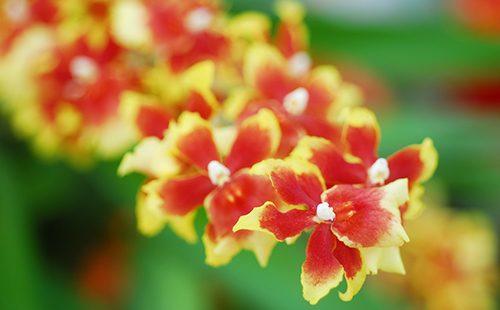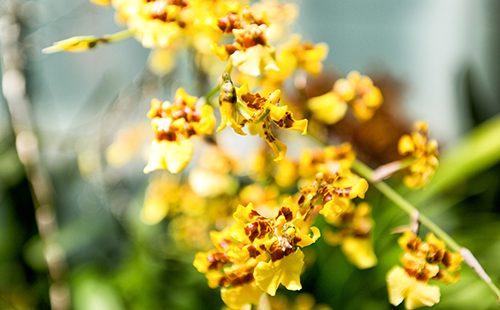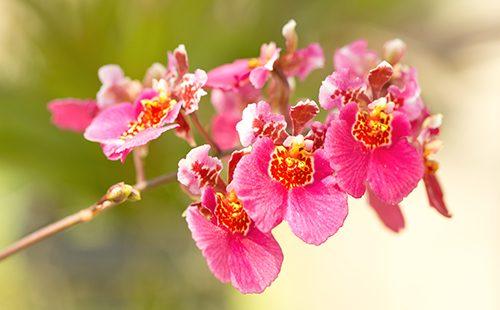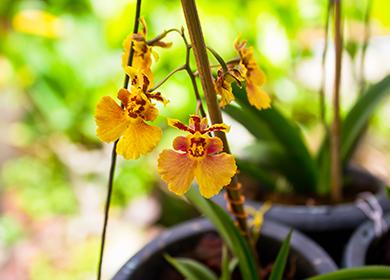The content of the article
In the wild, the plant settles mainly on trees. It rarely grows in rocky terrain between stones. For their unusual appearance, flower growers call it a "dancing chrysalis" or "tiger orchid."
Botanical Description
Orchid oncidium belongs to the family of orchis, or orchids. The genus includes about 600 varieties. All of them grow in tropical climates. Most often found on the American continent, less often in Mexico and the West Indies.
Most representatives of the genus of oncidiums are epiphytes, that is, they grow on trees, clinging to their bark. These are not parasitic plants - they get most of the nutrients from the air using aerial roots. Despite the variety of varieties of oncidiums, there are some common features.
All species have developed aerial roots covered with a thick layer of velamen. Velamen is a spongy hygroscopic tissue from dead cells. It easily absorbs and retains moisture.
A sympodial type of growth is characteristic - branches branch from the main shoot, forming a single bush. Rhizome grows in the horizontal direction. Vertical shoots departing from it, forming thickenings - pseudobulbs. Each new shoot grows from a bud located at the base of the previous growth. There are viable buds on other nodes, but they wake up only in emergency conditions - to restore a dying plant. A characteristic feature of oncidiums is the small size of the rhizome.
The pseudobulbs are oval, gradually wrinkling, acquiring a fusiform shape. Each of them produces up to three ribbon-like leaves. Old leaves gradually die off, only the dried film cover around the pseudobulb remains. Leaves are strap-shaped or lanceolate, slightly folded along the central vein.
Peduncle appears from the sinus of the lower leaf. At first it is straight, with the formation of branches with time. Paniculate inflorescences consist of many small zygomorphic flowers - they have only one plane of symmetry.
Popular varieties
Natural species and hybrids are grown in apartments. Varieties obtained as a result of selection are usually less capricious, blooming more easily. Among florists, nine varieties of oncidium deserved special popularity.
- Oncidium yellow. The most famous, widespread species. It is characterized by relative unpretentiousness. The flowers are multiple, small, lemon yellow.
- Oncidium Twinkle. A miniature hybrid variety with high resistance to temperature extremes.It is covered with many small flowers of white, pink, red or yellow. The smell is specific, pleasant, reminiscent of the aroma of baked goods with cinnamon.
- Warty. Epiphyte with elongated, even bulbs, two light leaves. One inflorescence includes about a hundred small flowers of a rich yellow hue.
- Limming. Neat plant with small leaves. Bulbs are rounded, slightly flattened. Peduncle short, forms a limited number of larger buds. The color is yellow, with reddish or brownish spots.
- Papilionaceous. Only one leaf leaves a flat rounded pseudobulb. Coloring - olive, with a reddish pattern. The flowers resemble moths in shape. The most common color is light brown, decorated with large yellow spots.
- Winding. Flat pseudobulbs are located at a distance from each other. Each of them produces several spreading leaves. On a long peduncle, a loose inflorescence is formed. The flowers are small, the color is bright yellow, with reddish spots.
- Lanza. Pseudobulbs reduced (poorly developed), leaves are hard. Brown-violet spots are scattered on a green background. The flowers are yellow, with a greenish tint, smell pleasant.
- Beautiful. A rather tall look with neat flat bulbs and a shortened rhizome. Each pseudobulb produces only one sheet. Young leaves are grayish-green, with growth they acquire a brownish or purple hue. Branching at the peduncle is weak. On each peduncle, up to 20 yellow flowers bloom.
- Brindle. Pseudobulbs are oval, leaves are leathery. It differs from other species in large tiger flowers.
Care for the oncidium: what to consider
Only proper care of orchid oncidium at home will help to fully reveal the decorativeness of a capricious tropical beauty. For abundant flowering, you need to create comfortable conditions - choose the right lighting, work out the optimal watering regime. Each variety and even a variety has small subtleties of cultivation, but the main parameters are the same.
Lighting
For full development and flowering, the oncidium needs bright lighting, but without direct sunlight. Delicate leaves quickly get sunburn in the form of reddish-brown spots. You can determine the optimal level of lighting by the color of the leaves.
If they are dark - there is not enough light, if light green with a reddish tint - too much. The normal color of the leaves of oncidium is bright green. You can place an orchid on any window except the north one. On the southern windows, you must definitely shade the flower with tulle.
Temperature
Inexperienced gardeners often have problems with the temperature regime. Some species grow in warm tropical forests, others in a rocky area, at a high altitude. This determines the requirement for conditions of detention.
Oncidiums are divided into heat-loving, requiring moderate heat, and cold-loving. When buying, it is better to check with the seller the variety of oncidium and the conditions for its cultivation. Requirements for the temperature regime are given in the table.
Table - Temperature for different varieties of oncidium
| Requirements | Growing area | Species and varieties | Favorable temperature |
|---|---|---|---|
| Heat loving | Tropics | - limming; - Lanza | - In the summer of 25-30 ° C; - in the winter of 15-18 ° C |
| Loving moderate warmth | Foothill areas | - brindle; - beautiful | - In the summer of 18-22 ° C; - in winter 12-15 ° C |
| Cold-loving | Mountain forests | - Twisty; - warty | - In the summer of 18-22 ° C; - in the winter of 7-12 ° C |
Air humidity
With the help of aerial roots, the oncidium receives moisture and nutrition from the air, therefore it suffers from insufficient air humidity. The lower threshold is 40%. If the humidity is lower, the leaves begin to dry, the orchid ceases to fully develop and bloom. Particularly closely monitor humidity indicators in the winter - heating appliances drain air.
The optimum air humidity is around 70%. Local moisture increase is achieved by spraying foliage and aerial roots. Additionally, batteries are hung with a wet cloth, humidifiers are installed. A flower pot is placed in a tray with a moist filler - sand, pebbles, sphagnum. When the air temperature drops below 18 ° C, the spraying is stopped. The room is regularly ventilated so that there is no air stagnation - this leads to the development of rot.
Features of watering
The most common watering method is dipping. Water is poured into the basin a little warmer than room temperature, the pot is lowered into it for 15–20 minutes. During this time, the substrate is completely saturated. The pot is removed from the water, placed on a pallet to drain excess liquid.
The drainage holes should be large enough so that moisture does not stagnate in the root area. Frequent drying of the soil is undesirable - the roots may not recover after the stress. Oncidium needs to be watered differently at each stage of growth.
- Forcing a sprout from an adult pseudobulb. Until the appearance of a new sprout from an adult pseudobulb, the oncidium is watered frequently and abundantly. The substrate must be stably moist.
- The growth of a new pseudobulb. At the stage of growth of a new pseudobulb, watering abruptly ceases.
- The appearance of the peduncle. When a new peduncle appears from the bulb, watering resumes, gradually increasing their frequency and abundance.
Soil composition
In the reviews, flower growers recommend that beginners use ready-made primers for orchids. They have a balanced composition, contain all the necessary nutrients. Before use, the substrate must be disinfected - watered with a weak solution of potassium permanganate.
Independently, the soil for oncidium is composed of pine bark, peat, sphagnum and coal. The composition is dominated by bark of different fractions - large, medium and small. Before use, the bark is soaked for 24 hours, and kept in a potassium permanganate solution for a couple of hours.
Transfer
An oncidium transplant is carried out only in case of emergency - if the pot has become too small, the substrate has become unusable, or there are problems with the root system. Like all orchids, the oncidium painfully responds to this procedure.
The pot is chosen wide and shallow - suitable plastic containers. As drainage, a third of the volume is filled with large pieces of bark. The orchid is planted near the edge of the pot, leaving her room for growth. Only roots are buried in the substrate - pseudobulbs should remain on the surface.
Top dressing
Oncidium must be fertilized taking into account the growth phase. During the growth of shoots, mineral substances are applied regularly. At the stage of formation of new pseudobulbs, top dressing is stopped. With the beginning of the growth of the peduncle, you can feed several times. After the first flower blooms, the fertilizer application is again stopped.
Oncidium is susceptible to the amount of fertilizer in the soil - they are applied very carefully. For feeding use special complexes for orchids - the concentration is taken ten times less than indicated in the instructions.Fertilizers are applied to the soil after watering. Alternate root and foliar top dressing.
Breeding methods
Oncidiums live for a long time, rejuvenating themselves due to the appearance of new bulbs. In nature, the lifespan of these orchids reaches 150 years. The easiest way to propagate the oncidium bulb. In most cases, this is the only way to get another young plant. Reproduction is combined with a transplant. You can only plant an adult bush that has formed more than six bulbs. The division of the bush is carried out in three stages.
- Training. Oncidium is abundantly watered. After a couple of hours they take it out of the pot, inspect and untangle the roots. If rot is detected, cut it to a healthy tissue, sprinkle with charcoal powder.
- Division. A sterile knife cut the rhizome into pieces. Each dividend should consist of three adult pseudobulbs. Slices are covered with garden varnish, sprinkled with charcoal or ash.
- Landing. Fill the pot with fresh soil. An orchid is placed on the edge, the roots are evenly distributed, they are sprinkled on top of the substrate, slightly compacted. To give stability, a support is installed. The first week they adhere to a gentle regime - they do not water, they shade from the sun.

Resuscitation of a flower without roots
A fairly common problem when growing oncidium is the loss of roots as a result of excessive watering, prolonged drying of the soil, improper care. In most cases, it is possible to reanimate the affected orchid, creating favorable conditions for the growth of new roots. The ability of a plant to recover can be determined by the state of pseudobulbs - they should not have extensive areas of rot. Perform the following procedure for resuscitation.
- Training. The orchid is taken out of the pot, the roots are cleaned of the remnants of the bark. All decayed areas are cut to a healthy tissue, sections are cauterized with brilliant green. For a day, the oncidium is left in a shaded, well-ventilated place - the slices should dry.
- Landing. A substrate is prepared from a medium-sized pine bark and crushed sphagnum. The mixture is pre-treated with steam. The finished substrate is poured into a shallow dish. The plant is placed on the surface, fixed with supports.
- Care. Pseudobulbs are often sprayed with warm water. Once a week, a small amount of fertilizer is added to the water. The procedure must be repeated for two to three months, until new roots appear.
Growing problems
Oncidium is a rather difficult crop to grow. The slightest violation of the conditions of detention leads to problems with leaves, roots, bulbs. A description of the most common difficulties can be found in the table.
Table - Oncidium Care Errors
| Outward manifestation | Cause | Help the plant |
|---|---|---|
| Leaves turn pale, become translucent, covered with bright dots | Sunburn | Rearrange the orchid in a shaded place |
| Pseudobulbs shrink, leaf ends dry | - Low humidity; - rare spraying | - More often sprayed; - take measures to increase humidity |
| Dark weeping spots appear on pseudobulbs and leaves | - Excessive watering in combination with cold; - spoiled soil | - Cut rotted areas, disinfect slices; - transplanted into a new substrate |
| Light formless spots appear on the foliage | - Excess trace elements; - the use of improperly selected fertilizer | - Stop feeding until healthy leaves appear |
| Foliage turns yellow | - Use of hard water for irrigation; - landing in an unsuitable substrate; - problems with the root system | - Transplant oncidium with a complete replacement of the soil; - inspect, if necessary, revive the roots |
| Closed buds dry, fall off | - lack of light; - depleted soil | - Transplant the orchid into a new substrate; - rearranged to a brighter place |
| Oncidium does not bloom | - Non-compliance with the phase of rest; - lack of daily temperature drops; - incorrect irrigation mode; - lack of natural light | Correct conditions |

Major diseases and their treatment
Oncidium is susceptible to all diseases of orchids. Florists have to deal with fungal, viral, bacterial diseases. In each case, the treatment will be different. You can determine the disease by characteristic signs using the table.
Table - Oncidium Diseases
| Disease name | Signs of the disease | Treatment |
|---|---|---|
| Leaf spotting | - Yellowish, gradually turning brown spots appear on the foliage | Infected plant is thrown away |
| Bronze virus | - Foliage is deformed; - roughened areas and brownish spots appear | - Inspect the oncidium for the presence of thrips (carrier) to prevent infection of other plants; - throw an orchid |
| Fusarium rot | - There is yellowing and fading of individual leaves; - a whitish-pink plaque forms on the root neck | Repeatedly treated with "Fitosporin", "Fundazole", any other fungicides |
| Anthracnose | Dark indentations form on foliage | - Keep at low humidity; - stop spraying and watering; - treated with Fundazolum, Rovralm |
| Gray rot | - Petals of flowers are covered with specks; - leaves, pseudobulbs soften; - a gray coating appears | - Remove old leaves and dying tissue; - stop watering and spraying; - often ventilate the room; - processed by “Skor”, “Purebloom” |
| Late blight | - Individual leaves fade and dry; - rot spreads along the stem and leaves | - Reduce humidity; - provide an influx of fresh air; - sprayed with "Ridomil", "Fitosporin" |
| Root rot | - Foliage loses its gloss, turns pale, turns yellow; - roots soften, exfoliate | - Transplanted by removing damaged roots; - watered with a solution of Fitosporin |
| Cercosporosis | - Black or purple patches appear on the back of the foliage; - gradually the leaves die and fall off | - The affected sheets are cut; - treated with the drug "Mancozeb"; - watering is temporarily stopped; - reduce air humidity |

Frequent pests and ways to control them
No less trouble for gardeners is pests. They not only harm the plant, but also are carriers of dangerous diseases. The earlier insects are noticed and appropriate measures are taken, the faster the orchid will recover. The most common pests are described in the table.
Table - Oncidium Pests
| Pest name | The appearance of the plant | Ways to fight |
|---|---|---|
| Mealybug | - On the back of the leaves appears a thin layer of whitish waxy coating; - lumps are formed, similar to cotton wool | - Wash in the shower with potash or laundry soap; - sprayed with "Actellicus", "Mospilanom"; - put on a plastic bag for two days; - after a week, repeat the treatment |
| Shield | - Brown rounded growths form on the leaves; - red or yellow appears around the growths; - the oncidium stops growing, withers | - Places of accumulation of insects are sprayed with alcohol; - two hours later, they collect the guards manually; - bathe an orchid under a warm shower; - treated with "Fozalon", "Fosbetsidom"; - after five days, the procedure is repeated |
| Thrips | - Silvery strokes appear on the leaves, similar to scratches; - holes form on the petals; - pollen from flowers is showered | - Spray the orchid with alcohol, after 15 minutes wash it off in the shower; - processed by Fitoverm, Actellik; - the procedure is repeated at ten-day intervals until the complete disappearance of insects |
| Spider mite | - On the underside of the sheet appear pale yellow spots; - leaves and flowers are covered with a thin web | - Apply a soap-alcohol solution to the orchid, wash it off in the shower after half an hour; - sprayed with warm water, covered with a bag, left for three days; - with severe damage, acaricides are used |
| Aphid | - Young leaves, peduncle and flowers are covered with colonies of small insects; - a sticky sugar coating appears; - the plant is deformed, loses decorativeness | - Insects are washed off with a soapy sponge in the shower; - sprayed with "Iskra", "Actara", "Biotlin" |
Caring for an oncidium is not easy - it requires increased attention, compliance with the irrigation regime, a certain temperature and humidity level. Flower growers, amateurs who have not yet encountered orchids, it is better to begin the experience of growing them with phalaenopsis. For more experienced florists, oncidium will be a worthy specimen in the orchid collection.

